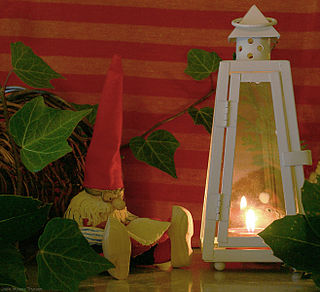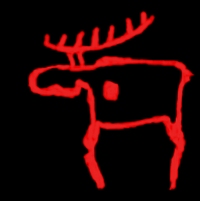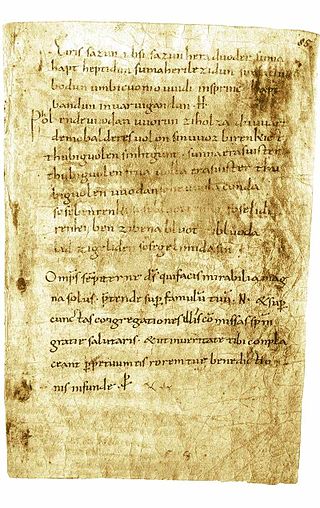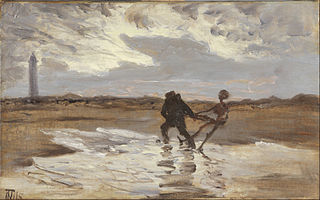
A troll is a being in Nordic folklore, including Norse mythology. In Old Norse sources, beings described as trolls dwell in isolated areas of rocks, mountains, or caves, live together in small family units, and are rarely helpful to human beings.

A nisse, tomte, tomtenisse, or tonttu is a mythological creature from Nordic folklore today typically associated with the winter solstice and the Christmas season. They are generally described as being short, having a long white beard, and wearing a conical or knit cap in gray, red or some other bright colour. They often have an appearance somewhat similar to that of a garden gnome.

A hulder is a seductive forest creature found in Scandinavian folklore. Her name derives from a root meaning "covered" or "secret". In Norwegian folklore, she is known as huldra. She is known as the skogsrå "forest spirit" or Tallemaja "pine tree Mary" in Swedish folklore, and ulda in Sámi folklore. Her name suggests that she is originally the same being as the völva divine figure Huld and the German Holda.

The Nixie, Nixy, Nix, Näcken, Nicor, Nøkk, or Nøkken are humanoid, and often shapeshifting water spirits in Germanic mythology and folklore.
Nordic folklore is the folklore of Denmark, Norway, Sweden, Iceland and the Faroe Islands. It has common roots with, and has been mutually influenced by, folklore in England, Germany, the Low Countries, the Baltic countries, Finland and Sápmi. Folklore is a concept encompassing expressive traditions of a particular culture or group. The peoples of Scandinavia are heterogenous, as are the oral genres and material culture that has been common in their lands. However, there are some commonalities across Scandinavian folkloric traditions, among them a common ground in elements from Norse mythology as well as Christian conceptions of the world.

Tanngrisnir and Tanngnjóstr are the goats who pull the chariot of the god Thor in Norse mythology. They are attested in the Poetic Edda, compiled in the 13th century from earlier traditional sources, and the Prose Edda, written by Snorri Sturluson in the 13th century.

Finnic paganism is the indigenous pagan religion in Finland, Karelia, Ingria and Estonia prior to Christianisation. It was a polytheistic religion, worshipping a number of different deities. The principal god was the god of thunder and the sky, Ukko; other important gods included Jumo (Jumala), Ahti, and Tapio. Jumala was a sky god; today, the word "Jumala" refers to all gods in general. Ahti was a god of the sea, waters and fish. Tapio was the god of forests and hunting.

The vættir are spirits in Norse mythology. The term can be used to refer to the full cosmos of supernatural beings, including the álfar (elves), dvergar (dwarves), jötnar (giants), and gods. Vættir can also refer more specifically to landvættir, fjallvættir, sjóvættir, skogvættir, vatnavættir, or húsvættir.

The church grim is a guardian spirit in English and Nordic folklore that oversees the welfare of a particular Christian church, and protects the churchyard from those who would profane and commit sacrilege against it. It often appears as a black dog but is known to take the form of other animals. In modern times, when black dogs are kept as pets in churches and their attached parsonages, these are called church Grims since they reside on and guard ecclesiastical property.

The Merseburg charms or Merseburg incantations are two medieval magic spells, charms or incantations, written in Old High German. They are the only known examples of Germanic pagan belief preserved in the language. They were discovered in 1841 by Georg Waitz, who found them in a theological manuscript from Fulda, written in the 9th century, although there remains some speculation about the date of the charms themselves. The manuscript is stored in the library of the cathedral chapter of Merseburg, hence the name.

Fossegrim, also known simply as the grim (Norwegian) or Strömkarlen (Swedish), is a water spirit or troll in Scandinavian folklore. Fossegrim plays the fiddle, especially the Hardanger fiddle. Fossegrim has been associated with a mill spirit (kvernknurr) and is related to the water spirit (nokken) and is sometimes also called näcken in Sweden. It is associated with river streams and particularly with cascading streams and mill races.

A Gjenganger in Scandinavian folklore was a term for a revenant, the spirit or ghost of a deceased from the grave.

"Maid Maleen" is a German fairy tale collected by the Brothers Grimm, number 198.

Ubume are Japanese yōkai of pregnant women. They can also be written as 憂婦女鳥. Throughout folk stories and literature the identity and appearance of ubume varies. However, she is most commonly depicted as the spirit of a woman who has died during childbirth. Passersby will see her as a normal-looking woman carrying a baby. She will typically try to give the passerby her child then disappear. When the person goes to look at the child in their arms, they discover it is only a bundle of leaves or large rock. The idea that pregnant women who die and get buried become "ubume" has existed since ancient times; which is why it has been said that when a pregnant woman dies prepartum, one ought to cut the fetus out the abdomen and put it on the mother in a hug as they are buried. In some regions, if the fetus cannot be cut out, a doll would be put beside her.
Vardøger, also known as vardyvle or vardyger, is a spirit predecessor in Scandinavian folklore.

Anne Olsdotter Godlid was a well-known Norwegian storyteller from Seljord, Telemark, Norway. She was noted for her excellent memory and proved an invaluable resource for collectors and Jørgen Moe, Magnus Brostrup Landstad, and Olea Crøger.
The tilberi (carrier) or snakkur (spindle) is a creature of Icelandic folklore, created by witches to steal milk. Only women can create and own them.
A troll cat is the familiar of a witch in Scandinavian folklore. Troll cats sucked milk from cows and spat it out in the witches' milk pails, and went into homes to lick up cream. Aside from cats, similar creatures include the milk rabbit, milk hare, and ball-shaped troll ball.
In Scandinavian mythology, the hug refers to an individual's mental life, in some contrast to the soul, a term which carries more spiritual connotations. Hug is the Norwegian term; the Danish term is hu, the Swedish håg; Scandinavian languages have a word for soul that is cognate with the English.
Reidar Thoralf Christiansen was a Norwegian folklorist, archivist of the Norwegian Folklore Collection (NFS) and professor of folkloristics at the University of Oslo.














